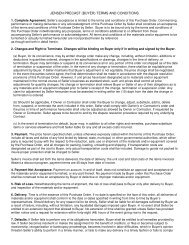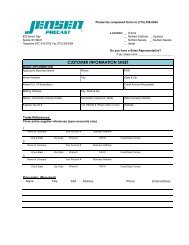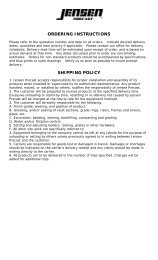Grease Interceptor O & M Manual (PDF) - National Precast Concrete ...
Grease Interceptor O & M Manual (PDF) - National Precast Concrete ...
Grease Interceptor O & M Manual (PDF) - National Precast Concrete ...
You also want an ePaper? Increase the reach of your titles
YUMPU automatically turns print PDFs into web optimized ePapers that Google loves.
<strong>National</strong> <strong>Precast</strong> <strong>Concrete</strong> Association<br />
NOTES<br />
1. This manual does not claim or imply that it addresses<br />
any safety-related issues associated with<br />
its use. Operation and maintenance of precast<br />
concrete grease interceptors may involve the use<br />
of or exposure to hazardous materials, operations<br />
and equipment. It is the user’s responsibility to<br />
determine appropriate safety, health and environmental<br />
practices and applicable regulatory requirements<br />
associated with the use of this<br />
manual.<br />
2. Use of this manual does not guarantee the proper<br />
function or performance of any grease interceptor<br />
operated or maintained in accordance with the requirements<br />
contained in the manual.<br />
3. This publication is designed to provide accurate<br />
and authoritative information in regard to the<br />
subject matter covered; however, the <strong>National</strong><br />
<strong>Precast</strong> <strong>Concrete</strong> Association acts as a mediator<br />
without approving, disapproving or guaranteeing<br />
the validity or accuracy of any data, claim or<br />
opinion appearing herein. Information is provided<br />
and disseminated with the understanding that the<br />
<strong>National</strong> <strong>Precast</strong> <strong>Concrete</strong> Association is not engaged<br />
in rendering engineering, legal or any<br />
other professional services. If engineering, legal<br />
or other professional assistance is required, the<br />
services of a competent professional should be<br />
obtained. The <strong>National</strong> <strong>Precast</strong> <strong>Concrete</strong> Association<br />
does not assume and hereby disclaims liability<br />
to any person for any loss or damage caused<br />
by errors or omissions in the material contained<br />
herein, regardless of whether such errors result<br />
from negligence, accident or any other cause<br />
whatsoever.<br />
2
OPERATION AND MAINTENANCE FOR PRECAST CONCRETE GREASE INTERCEPTORS<br />
INTRODUCTION<br />
With more than 900,000 restaurants and other<br />
food service establishments (FSEs) located in North<br />
America, the need for effective pretreatment for the<br />
wastewater they generate is vitally important. Ineffective<br />
grease removal from these waste streams results<br />
in the discharge of large quantities of grease into<br />
public sanitary sewer systems. Solidified grease can<br />
cause stoppages downstream in the piping networks<br />
and create costly and time-consuming problems at<br />
municipal wastewater treatment plants. <strong>Grease</strong> blockages<br />
can also cause considerable unnecessary health<br />
hazards when raw sewage backs up into residences<br />
or commercial establishments. By trapping fats, oils<br />
and greases (FOG) and solids normally found in FSEs,<br />
a grease interceptor is the last line of defense against<br />
potential problems downstream.<br />
Some municipalities charge sewer line maintenance<br />
fees and, if they can trace the source of a blockage<br />
causing a sanitary sewer overflow to a particular FSE,<br />
the FSE may be liable for the cleanup cost and fines.<br />
<strong>Grease</strong> interceptors are a necessary component of<br />
pretreatment programs and are generally necessary in<br />
order to comply with U.S. Environment Protection<br />
Agency (EPA) requirements.<br />
The greatest source of FOG loading comes from<br />
food service establishments that do not have a grease<br />
interceptor installed or from grease interceptors that<br />
are not properly maintained. This manual provides<br />
guidelines in the proper operation and maintenance of<br />
precast concrete grease interceptors, also known as<br />
gravity-type interceptors. These interceptors may<br />
have compartments and contain baffles to control the<br />
flow of wastewater and allow gravity separation of<br />
grease and solids from the wastewater stream.<br />
3
<strong>National</strong> <strong>Precast</strong> <strong>Concrete</strong> Association<br />
GREASE<br />
INTERCEPTOR<br />
DESIGN CODE<br />
INFORMATION<br />
This manual is not intended to be a basis of<br />
design or sizing, yet these issues will have an effect<br />
on how well the interceptor performs during average<br />
daily use and should be of major consideration when<br />
considering the proper interceptor for the intended<br />
function of the FSE (new or existing). There are<br />
numerous codes and standards available that the<br />
design engineer or jurisdictional authority may elect<br />
to use for sizing an interceptor (such as ASTM C890,<br />
ASTM C1613, UPC, IPC, local, state and provincial<br />
plumbing codes). Knowledge of these codes will be of<br />
great assistance for design and sizing of interceptors<br />
to be used in your region(s) of service.<br />
4
OPERATION AND MAINTENANCE FOR PRECAST CONCRETE GREASE INTERCEPTORS<br />
GREASE<br />
INTERCEPTOR<br />
FUNCTION<br />
In addition to proper maintenance and operation,<br />
there are three key characteristics that affect the<br />
functionality of gravity-type grease interceptors: retention<br />
time, flow and storage capacity.<br />
Retention time<br />
<strong>Grease</strong>s and oils have a lower specific gravity<br />
than water, so when a grease-laden mixture is left<br />
undisturbed, they will float to the surface while the<br />
sediment settles to the bottom. <strong>Grease</strong> interceptors<br />
use baffles and/or compartments to detain wastewater<br />
long enough for this process to occur. The Uniform<br />
Plumbing Code (UPC) in section 209.0 recognizes a<br />
retention time of 30 minutes.<br />
Flow<br />
The grease interceptors must be sized and configured<br />
to allow for sufficient retention time, taking into<br />
account the flow rate of the influent. Furthermore, it<br />
must be configured such that it minimizes turbulence<br />
to allow the suspended FOG to separate. This is especially<br />
important in high-flow situations, such as in the<br />
draining of a large sink or the discharge of dishwasher<br />
water.<br />
Storage capacity<br />
The interceptor must be large enough to allow for<br />
sufficient storage of accumulated FOG between cleaning<br />
operations without affecting the flow characteristics<br />
through the unit. Many jurisdictions use a 1.25<br />
factor in sizing to allow for a 25 percent accumulation<br />
of FOG and solids before cleaning.<br />
5
<strong>National</strong> <strong>Precast</strong> <strong>Concrete</strong> Association<br />
KITCHEN PRACTICES<br />
AND OPERATION<br />
There are no moving or mechanical parts in gravity-type<br />
grease interceptors that require operation or<br />
adjustment. Thus, the passive operation of the interceptor<br />
is affected by the way in which it is used and<br />
the substances that are allowed to enter it. Most regulatory<br />
agencies require FSEs to use Best Management<br />
Practices in their kitchens. The following kitchen<br />
practices will reduce interceptor maintenance costs:<br />
• Establish Best Management Practice stamdards in<br />
the kitchen to minimize FOG discharge.<br />
• Educate and train your staff on proper kitchen<br />
practices. Some regulatory agencies require proof<br />
that employees have been trained and comply<br />
with such practices.<br />
• Keep records of maintenance on site. Most jurisdictional<br />
authorities require proof that the interceptor<br />
has regular maintenance. See Appendix A<br />
for a sample maintenance log.<br />
• Post “No <strong>Grease</strong>” signs above sinks and other<br />
drainage fixtures.<br />
• Dry-wipe pots, pans and dishware prior to washing.<br />
• Use a 3-sink system with separate sinks for washing,<br />
rinsing and sanitizing.<br />
• Use dishwashing and general cleaning detergents<br />
that promote rapid oil/water separation. These<br />
detergents are formulated to release oil quickly<br />
so that the oil can rise to the water surface instead<br />
of remaining emulsified.<br />
• Use proper concentrations of cleaners and disinfectants.<br />
Excessive amounts of either can cause<br />
FOG to become emulsified and pass through the<br />
interceptor.<br />
• Do not use water that is hotter than necessary to<br />
clean and sanitize wash items. Use temperature<br />
settings recommended by the dishwasher manufacture.<br />
(Several agencies require water temperatures<br />
be limited to 140 degrees.)<br />
• Do not dispose of cooking oils, fats or grease into<br />
drains. Recycle waste cooking oils.<br />
• Do not use additives such as enzymes, grease<br />
solvents or emulsifiers. Most regulatory agencies<br />
prohibit their use. Enzymes and solvents temporarily<br />
emulsify grease, allowing it to pass<br />
through the interceptor. The grease later coagulates<br />
on the inside walls of sewer pipes, restricting<br />
flow, which could result in sewage backups<br />
and blockages.<br />
• Do not allow corrosive agents to drain into the<br />
grease interceptor.<br />
• Do not use food grinders. Most regulatory agencies<br />
prohibit their use. Dispose of food waste into<br />
a solids waste container. Although the interceptor<br />
is designed to remove grease-laden food particles<br />
from the wastewater stream, it also increases the<br />
pump-out interval and could lead to potential<br />
odor and/or reactivity problems due to food particles<br />
breaking down biologically and releasing<br />
gases within the interceptor.<br />
6
OPERATION AND MAINTENANCE FOR PRECAST CONCRETE GREASE INTERCEPTORS<br />
OTHER<br />
OPERATIONAL<br />
CONSIDERATIONS<br />
The service life of a precast concrete grease interceptor<br />
can be affected by improper use or irregular<br />
maintenance. In general, acids or acid-producing substances<br />
should not be allowed to enter grease interceptors<br />
in large quantities. A number of conditions<br />
can result in a corrosive environment for precast interceptors.<br />
Two examples are often cited:<br />
• a low pH effluent could result from a high concentration<br />
of sugar, yeast or food particles found<br />
in the waste stream from the FSE if allowed to go<br />
septic in the interceptor, and<br />
• the generation of corrosive products that result<br />
from a bacterial digestive process on the walls of<br />
the interceptor.<br />
Either of these items can contribute to a corrosive<br />
effect on concrete and be a result of excessive<br />
sizing and infrequent or improper cleaning of the interceptor.<br />
7
<strong>National</strong> <strong>Precast</strong> <strong>Concrete</strong> Association<br />
ODOR PREVENTION<br />
Odor issues with outdoor interceptors can be<br />
eliminated when a properly designed grease interceptor<br />
is incorporated into the building’s plumbing/venting<br />
system. Most building codes require the<br />
interceptor to be vented back through the inlet<br />
plumbing and to a roof vent. In almost all cases odor<br />
problems are caused by improper venting of the<br />
building’s plumbing system. This causes the gases to<br />
build up in the interceptor and allows them to escape,<br />
leading to odor problems. Proper building ventilation<br />
and interceptor design along with gastight manhole<br />
covers and seals will prevent odors from escaping the<br />
interceptor and allow them to properly escape<br />
through the roof vents. Additionally, when precast<br />
concrete gravity grease interceptors will be dormant<br />
for more than 30 days (schools, churches, etc.), the<br />
preferred practice is to pump and refill the interceptor<br />
with clean water before the long period of inactivity.<br />
8
OPERATION AND MAINTENANCE FOR PRECAST CONCRETE GREASE INTERCEPTORS<br />
CLEAN OUT &<br />
MAINTENANCE<br />
All interceptors require maintenance to ensure an<br />
acceptable level of effluent FOG. This requires a regular<br />
schedule of pumping and inspection. When the<br />
grease interceptor is new, it is difficult for the jurisdictional<br />
authority to define the maintenance schedule,<br />
and so it is difficult to ensure compliance. For<br />
these reasons, it may be best to require the owner or<br />
establishment to obtain and maintain a maintenance<br />
contract with a qualified waste removal business.<br />
For new installations, a monthly or bi-monthly<br />
cleaning may be required until the maintenance company<br />
can establish a predictable level of FOG accumulation<br />
for that particular facility. Thereafter, required<br />
cleanings may be extended until an optimum pumping<br />
frequency is determined. The jurisdictional authority<br />
may also require notification from either the owner or<br />
the maintenance company when a scheduled cleaning<br />
is performed (or missed) or when a contract is not renewed.<br />
Automated monitoring systems are now available<br />
that monitor the levels of FOG in the tank. They provide<br />
an early warning to management that the grease<br />
interceptor is nearly full and needs pumping. In addition,<br />
the systems can minimize pumping cost by optimizing<br />
pump-out interval. Automated systems provide<br />
documentation for the jurisdictional authority and can<br />
even be monitored offsite.<br />
Inspection<br />
• Service covers should be inspected for defects or<br />
missing bolts (if equipped). Check that the gasket<br />
(if equipped) is in place and not cracked or broken.<br />
Replace the gasket if needed.<br />
• Before pump-out, notice the liquid level. An unexpectedly<br />
low level could indicate a leaky tank,<br />
while an unexpectedly high level (or signs of<br />
grease above the normal operation level) could indicate<br />
a plugged fitting, line or filter.<br />
• Once the interceptor is pumped out, visually inspect<br />
all fittings, baffles and fixtures inside the interceptor<br />
to see that they are in good working<br />
condition and functioning properly.<br />
Pump-Out<br />
Follow the manufacturers recommended pump-out<br />
levels for FOG and sedimentation within the interceptor.<br />
On new installations, determining the pump-out<br />
interval will be difficult until the service company has<br />
monitored the accumulation rate enough to predict it.<br />
The manufacturer may provide information that will<br />
help determine when the interceptor is full and needs<br />
pumping. If information is not available, pump out the<br />
interceptor when the combined FOG and solids accumulation<br />
is near – but not in excess of – 25 percent<br />
of the total liquid depth.<br />
With compartmentalized grease interceptors, be<br />
9
<strong>National</strong> <strong>Precast</strong> <strong>Concrete</strong> Association<br />
sure that each compartment is checked, cleaned and<br />
inspected at the time of pump-out.<br />
It is important to scrape clean the side walls and<br />
baffles during pump-out to help maximize removal of<br />
greases from the interceptor during each cleaning.<br />
The settled materials should also be thoroughly vacuumed<br />
to prevent biological breakdown and the unwanted<br />
release of gases. If the interceptor is equipped<br />
with an effluent filter, make sure it is properly<br />
cleaned and maintained according to manufacturer’s<br />
instructions. WARNING: Do not enter the<br />
interceptor to perform maintenance.<br />
Once the pump-out has been completed, be sure<br />
that the area has been cleaned up, the effluent filter<br />
(if applicable) has been reinstalled and that the access<br />
covers have been placed and secured (if provided<br />
with bolts or other device).<br />
10
OPERATION AND MAINTENANCE FOR PRECAST CONCRETE GREASE INTERCEPTORS<br />
INTERCEPTOR INSPECTION<br />
EXAMPLES:<br />
SOLIDS MEASURING<br />
ROD AT TANK BOTTOM<br />
WHEN TANK IS CLEAN<br />
REMOVE CAST IRON COVER<br />
FOR MEASURING PROBES<br />
SOLIDS MEASURING<br />
ROD ON TOP<br />
OF SOLID LAYER<br />
1.) Obtain the FOG and/or solid levels using a<br />
“Sludge Judge” or a simple rod with a flat bottom<br />
piece to feel the mass levels within the recognized<br />
areas of separation, floatation and<br />
settling.<br />
3.) Measure the height of the solids. If the height of<br />
the solids and grease are greater than 25 percent<br />
of the liquid depth then the interceptor needs<br />
pumping.<br />
GREASE MEASURING<br />
ROD ON UNDERSIDE<br />
OF GREASE MAT<br />
REMOVE CAST IRON COVER<br />
FOR MEASURING PROBES<br />
2.) Measure the depth of the grease.<br />
NOTE: The grease interceptor model shown is for illustrative<br />
purposes only. It is not the only option for<br />
gravity-type grease interceptors. Contact one or<br />
more manufacturers to obtain additional information<br />
on the available options and models.<br />
11
<strong>National</strong> <strong>Precast</strong> <strong>Concrete</strong> Association<br />
SUMMARY<br />
<strong>Precast</strong> concrete grease interceptors offer a simple,<br />
efficient solution to a critical problem. Their performance<br />
and the degree of protection they provide<br />
for the sewer components located downstream are<br />
determined by the way in which they are used. As<br />
such, it is vitally important that grease interceptors be<br />
properly operated and maintained at all times.<br />
Contact your local jurisdictional authority with<br />
questions regarding permits, record-keeping requirements<br />
or any other maintenance issues that they may<br />
require to avoid costly sewer maintenance charges<br />
from improper grease discharges. The manufacturer<br />
of your interceptor should also be able to provide<br />
you with answers regarding the construction and operation<br />
of your grease interceptor and may be able to<br />
help you locate a licensed, qualified cleaning contractor<br />
who can offer a contract cost to maintain your interceptor<br />
and documentation required to assure<br />
compliance.<br />
12
OPERATION AND MAINTENANCE FOR PRECAST CONCRETE GREASE INTERCEPTORS<br />
APPENDIX A –<br />
MAINTENANCE LOG<br />
NOTE: Attach a drawing of the grease interceptor so<br />
the maintenance provider can properly inspect and<br />
service components.<br />
Copy and send to: _______________________________<br />
13





